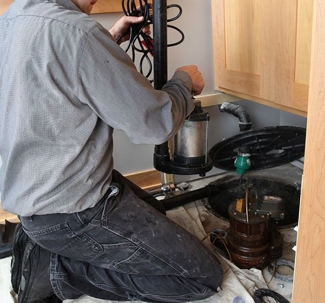
Why Is Sump Pump Maintenance So Important?
If you have a sump pump, you know how hard it works to protect your home. A sump pump is installed on the lowest level of your home, so it’s able to prevent flooding in your basement or crawlspace. Your sump pump is housed inside a sump pit out of the way, so it’s easy to forget about it unless it stops working.
A sump pump sits in your home on standby, waiting for a reason to be activated. When there are heavy rains, your system will switch on once the groundwater around your home is high enough to activate the pump’s float switch. Once the system has removed the water away from your home, it will go back into standby status.
The water from the sump pump is typically drained into a storm drain, retention pond, or well. The sump pump acts as a fail-safe device preventing flooding in the lowest levels of your house. Because it serves such an important purpose, you must ensure your sump pump is in good condition and ready for action.
Sump Pump Maintenance Best Practices
By following a few sump pump maintenance best practices, you can keep your system in good condition. How often your system needs maintenance will depend greatly on seasonal weather conditions.
The harder your system works, the more maintenance it will need to ensure its components won’t become too worn. If your sump pump has been exposed to high levels of wear and tear, maintenance can ensure it doesn’t break down when you need it most.
Sump Pump Maintenance Checklist
The following steps will help you get your sump pump ready for action. It’s important to unplug your system from its power supply before performing any maintenance or inspections.
- Clear Debris from the Sump Basin: Access the sump basin and remove debris. All loose and lodged debris must be removed, so the pump is easier to access for additional cleaning.
- Check the Pump for Corrosion: Remove the pump from the basin. The discharge pipe will need to be removed from the pump as well. If the discharge pipe does not disconnect from the pump, it could be a sign of mold, corrosion, or buildup at the joint. Using a cloth or sponge, clean the pipe using a nonabrasive disinfectant. You can clean the pipe with just a damp cloth. If the pump is very soiled, you may need to rinse it first. Inspect the pump for corrosion. If you find any, contact your sump pump maintenance professional.
- Check the Pump Inlet Screen: Find the sump pump inlet screen at the pump’s base. The screen serves as a filter that keeps debris from damaging your system. You can use a brush to clean the filter, removing any debris that may be trapped. Depending on your system model, you can take this time to lubricate the pump’s bearings if recommended for your unit.
- Check the Discharge Pipe: Inspect the drainage system of your sump pump. You need to ensure your drainage system isn’t compromised and that nothing is preventing the free flow of drainage water. The discharge pipe should be carrying water at least 20 feet away from your foundation to keep your home protected.
How to Perform a Sump Pump System Test
The system test consists of the following:
- After cleaning your sump pump, replace all the parts and reconnect your system to its power supply.
- Add several gallons of water to the basin and wait for your system to turn on from standby automatically.
- During this test, ensure the float switch is operating properly. Once it activates to remove the water you placed in the basin, the maintenance routine is complete.
Choose Mallick Plumbing & Heating for Sump Pump Maintenance
If you need help maintaining your sump pump, our expert technicians are the pros you want on your side. At Mallick Plumbing & Heating, we are committed to providing our customers with exceptional plumbing services, which is why we are a preferred service provider throughout Maryland, Virginia, and the District of Columbia.
Call us at (301) 804-6759 or contact us online to schedule sump pump maintenance with the team at Mallick Plumbing & Heating today!
